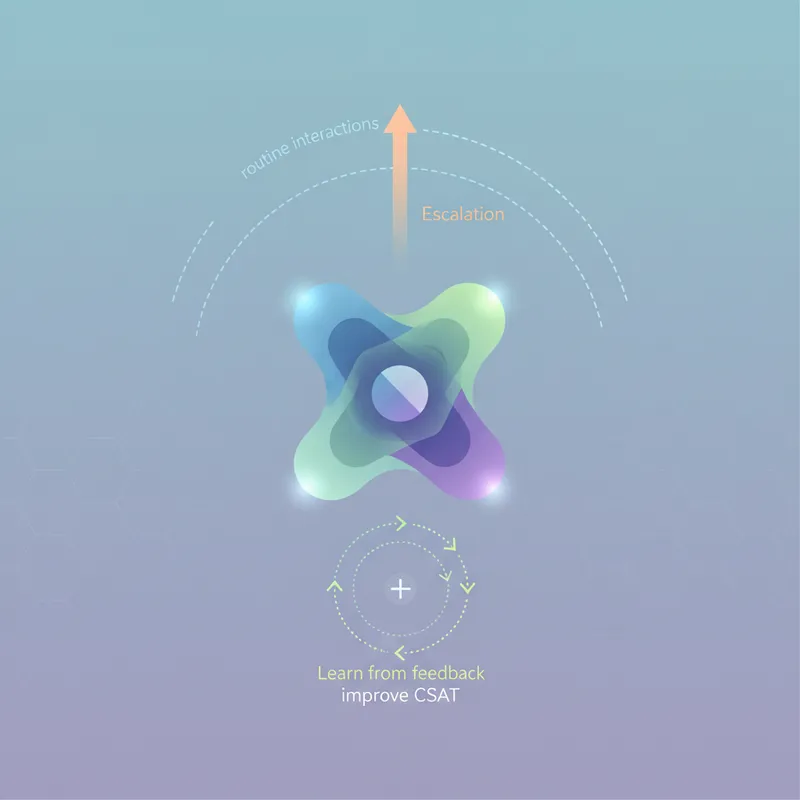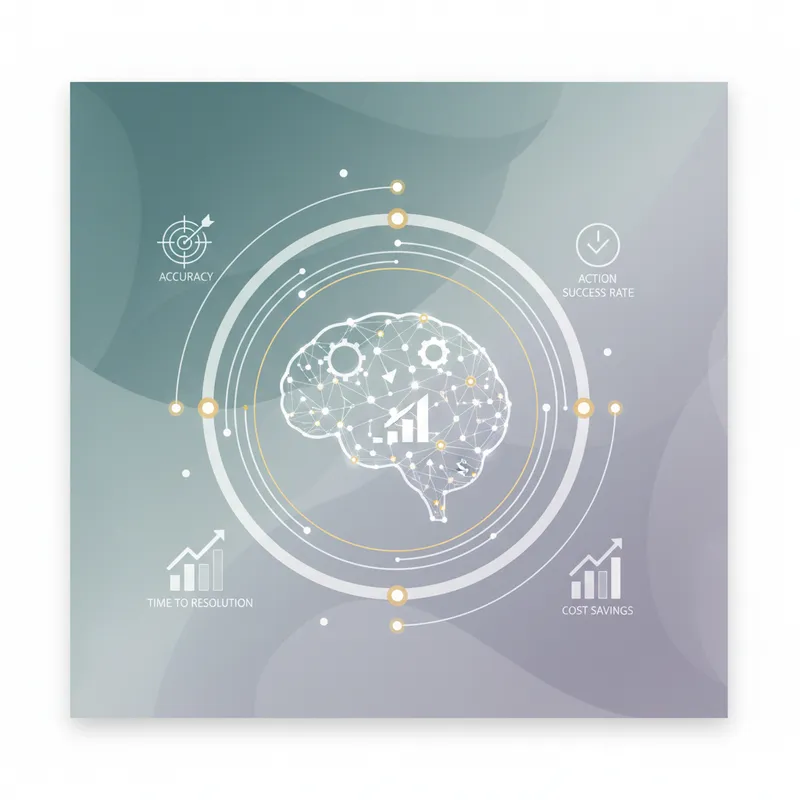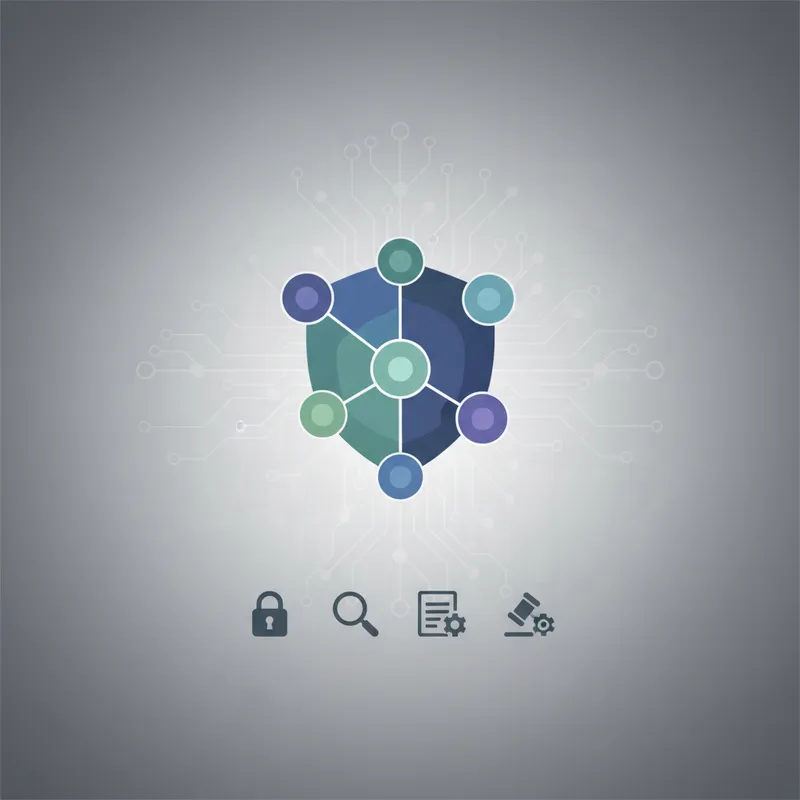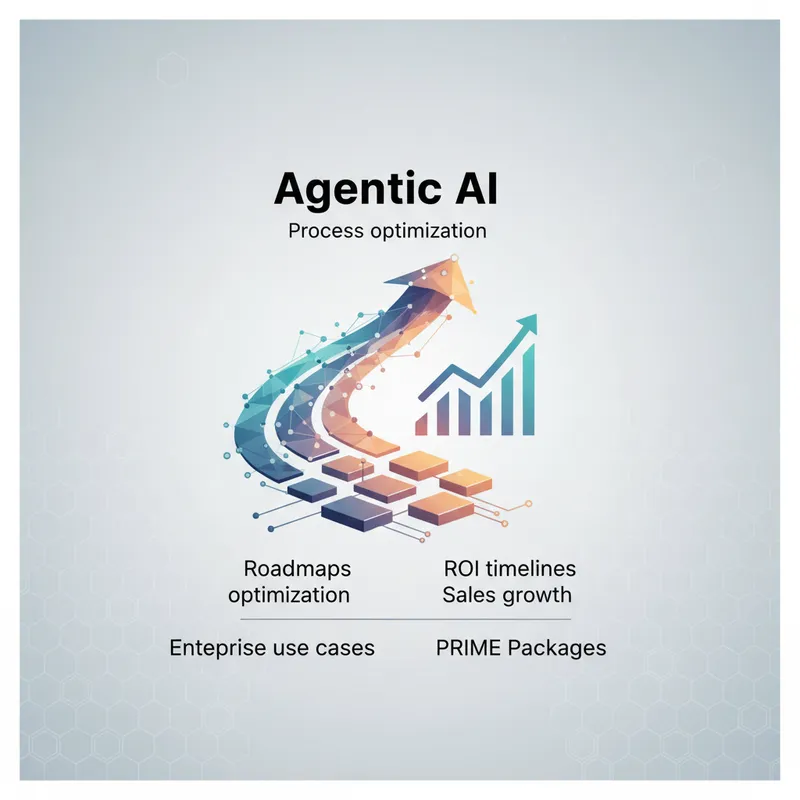
Agentic AI solutions for business are reshaping how enterprises convert strategy into measurable outcomes. By combining autonomous goal setting, multi step planning, and tool orchestration, agentic systems move beyond single task automation to execute complex workflows with minimal human oversight. The business value is not theoretical. Leading organizations use agentic AI solutions for business to accelerate response times, reduce operational cost, and unlock new revenue channels by embedding intelligent agents into sales operations, procurement, customer success, compliance, and product development. Learn more in our post on Security and Compliance for Agentic AI Automations.
This post maps a practical set of A.I. PRIME packages to common enterprise use cases. It provides sales oriented guidance to help decision makers choose the package that fits their environment, estimate implementation effort, and forecast realistic return on investment timelines. If your goal is to deploy agentic AI solutions for business that drive quick wins and sustained impact, the frameworks and ROI models below will help you build a clear business case and stakeholder roadmap.
What Are Agentic AI Solutions for Business and Why They Matter
Agentic AI solutions for business are a category of AI systems that take initiative, plan multi step strategies, and use external tools or data sources to complete missions with limited human direction. They elevate traditional automation by reasoning across steps, adapting when conditions change, and escalating only when necessary. For enterprise leaders, that means more reliable process completion, fewer manual handoffs, and faster cycle times for high value workflows. Learn more in our post on Investment Signals: What VC and Enterprise Spending in 2025 Means for Automation Buyers.
From a commercial perspective, agentic AI solutions for business offer three levers of value. First, cost reduction through automated execution of repetitive, multi step tasks. Second, revenue acceleration by enabling faster lead response, personalized outreach, and scaled customer interactions. Third, risk mitigation through consistent policy enforcement, audit trails, and proactive issue resolution. Those levers combine to produce compelling ROI when the right use cases and metrics are selected.
Adoption success depends on clear scoping, data readiness, governance, and an iterative deployment plan. Agentic AI solutions for business will not replace strategic oversight. Instead they amplify skilled teams by taking on routine orchestration and freeing people to focus on judgment and creativity. When packaged correctly for enterprise buyers, these solutions translate into repeatable value delivered across departments.
A.I. PRIME Packages: Overview and When to Choose Each
We designed the A.I. PRIME packages to help enterprises adopt agentic AI solutions for business with predictable outcomes. Each package includes a combination of capabilities, implementation services, and governance features tailored to organizational maturity. Below is an executive summary of the tiers and recommended scenarios. Learn more in our post on Market Map: Top Agentic AI Platforms and Where A.I. PRIME Fits (August 2025 Update).
A.I. PRIME Core: Entry level package for rapid pilots. Includes prebuilt agent templates, secure connectors for common data sources, and a one month implementation sprint. Choose this package for targeted pilots in customer service automation or internal help desk workflows.
A.I. PRIME Scale: Mid market package for department wide rollouts. Adds integration with enterprise systems, role based access, and performance dashboards. Best for scaling agentic AI solutions for business across sales operations or procurement workflow automation.
A.I. PRIME Enterprise: Full enterprise package with custom agent development, advanced compliance controls, and a dedicated success team. Use this package for mission critical processes such as regulatory compliance, end to end supply chain orchestration, or large scale personalization engines.
A.I. PRIME Continuous: Ongoing optimization and managed services. Includes A B testing, model governance, and a quarterly business review cadence. This package ensures agentic AI solutions for business evolve with shifting priorities and data drift.
Each package contains a clear modular feature set so teams can start small and expand. The goal is to minimize initial risk while enabling a path to broader, measurable impact. Agentic AI solutions for business deployed through the A.I. PRIME framework are designed to integrate with existing tooling and governance models to accelerate adoption and reduce friction.
Common Enterprise Use Cases and Package Mapping
Agentic AI solutions for business are applicable across functions. Below are common enterprise use cases, the recommended A.I. PRIME package, expected implementation complexity, and typical KPIs to track.
Customer Service Triage and Resolution
Recommended package: A.I. PRIME Core or Scale.
Complexity: Low to Medium. Prebuilt agent templates can handle common queries, escalate complex cases, and synchronize with CRM records.
KPIs: First response time, resolution rate, cost per interaction.
Sales Pipeline Acceleration
Recommended package: A.I. PRIME Scale.
Complexity: Medium. Agents qualify inbound leads, schedule demos, and prepare personalized briefings for sellers by integrating with CRM and calendaring systems.
KPIs: Lead conversion, time to first contact, pipeline velocity, average deal size.
Procurement and Source to Pay Automation
Recommended package: A.I. PRIME Enterprise.
Complexity: High. Agents manage RFQ workflows, negotiate using contracted terms, and route approvals with audit logs.
KPIs: Cycle time for purchases, savings on negotiated spend, compliance rate.
Compliance Monitoring and Incident Response
Recommended package: A.I. PRIME Enterprise plus Continuous.
Complexity: High. Agents monitor for policy violations, initiate containment playbooks, and generate evidence packets for auditors.
KPIs: Mean time to detect, mean time to remediate, incident recurrence.
Product Research and Competitive Insights
Recommended package: A.I. PRIME Scale or Enterprise.
Complexity: Medium. Agents aggregate signals, generate summaries, and flag high impact opportunities for product teams.
KPIs: Time saved on insights generation, speed of product iterations, idea to prototype time.
HR Onboarding and Employee Services
Recommended package: A.I. PRIME Core or Scale.
Complexity: Low. Agents guide new hires through paperwork, set up accounts, and schedule orientation tasks.
KPIs: Onboarding time, employee satisfaction, HR staff time saved.
Expected ROI Timelines and Financial Models
Decision makers need credible ROI timelines when evaluating agentic AI solutions for business. Below are practical models and conservative benchmarks based on typical enterprise deployments. These timelines assume basic data readiness and executive sponsorship.
Short term wins 3 to 6 months. Use A.I. PRIME Core for pilot projects that deliver rapid outcomes. Example: Deploying an agentic support triage agent can reduce cost per ticket by 30 percent within three months by automating 40 percent of inbound queries. Financially this often produces a positive operational cash flow impact within a single quarter.
Medium term impact 6 to 12 months. Expand to A.I. PRIME Scale to integrate agents across departments. Example: A sales acceleration agent that qualifies leads and prepares buyer insights can increase conversion rates by 10 to 20 percent within six months. When applied to an existing pipeline this often yields a double digit uplift in quarterly revenue and short payback periods.
Long term transformation 12 to 24 months. Adopt A.I. PRIME Enterprise and Continuous for enterprise grade orchestration. Example: Replacing manual procurement workflows with agentic negotiation and approval agents can lower procurement cycle time by 50 percent and reduce maverick spend. ROI here is realized across multiple budget cycles and often includes both hard savings and avoided cost from compliance failures.
Example ROI model
Define baseline. Capture current cost and throughput for the targeted process.
Estimate automation potential. Use conservative automation rates for agentic AI solutions for business such as 30 to 50 percent task automation for well defined processes.
Quantify time savings. Translate automation into FTE equivalents and compute labor cost reductions.
Include revenue uplift. When agents accelerate revenue processes, attribute a conservative percentage of pipeline uplift to the agentic system.
Account for implementation costs. Include subscription fees, integration, and one time setup costs over a two year window.
Calculate payback and IRR. Most pilots recoup costs within 6 to 12 months when targeted at high volume processes.
How A.I. PRIME Comes Together: Technical Components and Services
A successful deployment of agentic AI solutions for business requires a blend of technical components and professional services. A.I. PRIME focuses on five core areas to reduce friction and accelerate time to value.
Agent Templates and Orchestration
Prebuilt templates for common enterprise goals enable faster pilots. Templates include decision logic, escalation rules, and connector patterns to enterprise systems.
Secure Integrations
Native connectors for CRM, ERP, ticketing, cloud storage, and identity systems reduce custom integration work. Secure credential management and role based access ensure data exposure is minimized.
Human in the Loop Controls
Approval gates, review queues, and simulation modes let teams build trust with agents before full autonomy. These controls are critical for regulatory and mission critical processes.
Monitoring and Observability
Performance dashboards track KPIs, agent decisions, and audit trails. Observability helps business users understand impact and supports continuous improvement.
Governance and Compliance
Policy frameworks, model validation practices, and data lineage features make agentic AI solutions for business auditable and defensible. This is crucial for regulated industries and high risk workflows.
Implementation services available in each package include discovery workshops, data mapping, agent configuration, change management, and training. A.I. PRIME Continuous adds a managed service layer to run experiments, tune decision logic, and update agents as business rules evolve.
Implementation Roadmap with Milestones
A clear roadmap reduces deployment risk and sets expectations for stakeholders. Below is a typical 6 to 12 month roadmap for rolling out agentic AI solutions for business using A.I. PRIME packages.
Month 0 to 1: Discovery and Pilot Design
Identify target process, map stakeholders, measure baseline KPIs, and select the A.I. PRIME package. Define success criteria and data needs.
Month 1 to 3: Pilot Implementation
Configure agents, connect data sources, and run a controlled pilot. Use human in the loop reviews and collect performance data against KPIs.
Month 3 to 6: Scale and Integrate
Extend agent reach, integrate with adjacent systems, and automate additional decision points. Begin training teams on new workflows and measure initial ROI.
Month 6 to 12: Enterprise Rollout and Optimization
Deploy across departments, standardize governance, and onboard a central operations team. Use A.I. PRIME Continuous for ongoing performance tuning and expansion planning.
This structured approach aligns technical delivery with business goals and ensures agentic AI solutions for business scale safely and predictably. Early emphasis on observability and training pays dividends during enterprise expansion.
Risk Management, Compliance, and Ethical Considerations
Agentic AI solutions for business introduce new operational and ethical dimensions. Managing these risks is a central part of any adoption plan. First, ensure that agents operate within clearly defined policies and that escalation paths exist for ambiguous situations. Second, implement logging and explainability features so decisions are auditable. Third, validate models regularly to prevent drift and unintended behavior.
For regulated industries, build governance checklists into the deployment plan. Keep data minimization and privacy by design principles at the forefront. Employ role based access and encryption for sensitive connectors. Finally, maintain a human led appeals process for any automated decision that materially affects customers or employees.
By embedding risk controls into the A.I. PRIME packages, organizations can scale agentic AI solutions for business while meeting compliance obligations and preserving stakeholder trust. Ongoing training and a culture of continuous review are important to ensure agents continue to act as intended as business conditions change.

Sales Playbook: Selling Agentic AI Solutions for Business
Selling agentic AI solutions for business requires translating technical capabilities into business outcomes. Start by profiling buyer personas and identifying economic sponsors. CFOs care about payback and cost reduction. Heads of customer success focus on retention and satisfaction. Procurement leaders emphasize compliance and savings. Tailor your pitch to the metrics that matter to each stakeholder.
Use proof points from pilot data. Show how A.I. PRIME Core produced a measurable reduction in labor hours for a subset of tasks or how a Scale deployment increased conversion rates. Provide realistic deployment timelines and highlight governance controls that mitigate risk. Offer a pilot to demonstrate value before seeking a broader commitment.
Positioning advice
Lead with measurable KPIs and a conservative ROI model.
Offer a clear expansion path from Core to Enterprise to Continuous.
Show integration points and highlight security features required by IT and compliance teams.
Provide customer success plans that include training and change management resources.
When sales teams can articulate the business case in financial terms and show a short time to value, procurement cycles shorten and executive alignment becomes easier. Agentic AI solutions for business sell best when buyers understand both the near term gains and the long term strategic value.
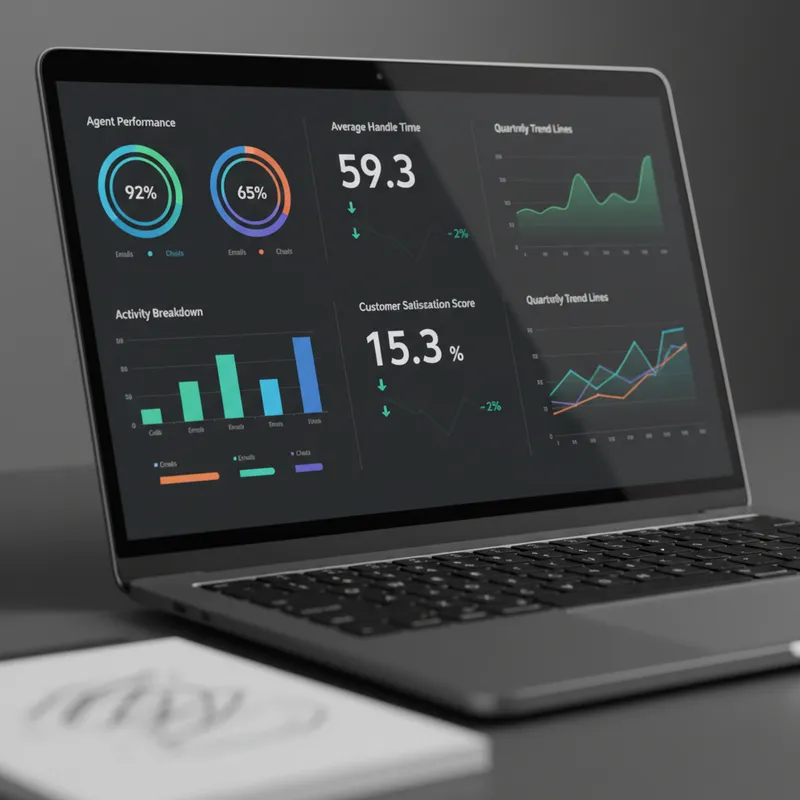
Operational Best Practices and Change Management
To realize the full potential of agentic AI solutions for business, invest early in operational readiness. Establish a central agent operations team responsible for monitoring performance, tuning decision logic, and managing exceptions. Define clear roles and responsibilities for business owners, IT, legal, and data teams.
Change management matters. Introduce agents with transparent communications about what will change and why. Train frontline staff on how to escalate exceptions and interpret agent recommendations. Use phased rollouts and sandbox environments to build confidence before full production deployment.
Measure adoption and user satisfaction alongside performance metrics. When end users see direct benefits to their daily work and feel supported through transition, adoption accelerates and the business realizes agentic AI solutions for business more quickly.
Sample Use Case Scenarios with ROI Estimates
Below are three anonymized scenarios that illustrate how agentic AI solutions for business deliver value. Each scenario includes baseline assumptions and expected financial outcomes.
Scenario A: Support Triage for a Technology Company
Baseline: 10,000 tickets per month, average handle time 20 minutes, 100 support FTEs.
Intervention: Deploy A.I. PRIME Core to automate triage and resolve 35 percent of tickets autonomously while escalating complex issues.
Outcome: Labor reduction equivalent to 14 FTEs, annual labor savings 15 percent. Expected payback in 4 months. Additional benefit: improved customer satisfaction and reduced churn risk.
Scenario B: Sales Acceleration for a SaaS Vendor
Baseline: $20 million annual recurring revenue, average conversion rate 8 percent from inbound leads.
Intervention: Deploy A.I. PRIME Scale to qualify leads and personalize outreach, increasing conversion by 12 percent.
Outcome: Incremental revenue increase of $240,000 in the first six months with payback on implementation costs within 6 to 9 months. Upside: shorter sales cycles and improved seller productivity.
Scenario C: Procurement Automation for a Manufacturing Firm
Baseline: Annual purchasing spend $500 million, manual PO processing costs high, maverick spend 8 percent.
Intervention: Deploy A.I. PRIME Enterprise to manage approvals and negotiate standard contracts.
Outcome: Reduction in maverick spend by 3 percentage points, process savings across procurement operations, and improved compliance. Multi year ROI exceeds 150 percent with primary returns realized in year one and strategic benefits accumulating over two years.
These scenarios are conservative and reflect common enterprise outcomes for agentic AI solutions for business when projects are well scoped and supported by executive sponsors. Real world results will vary based on process complexity, data quality, and change management effectiveness.
Measuring Success: Key Metrics and Dashboards
To prove value, track a combination of operational, financial, and experience metrics. Operational metrics show throughput and efficiency gains. Financial metrics quantify cost reductions and revenue impact. Experience metrics reflect customer and employee sentiment.
Recommended KPI set
Automation rate percentage for targeted process steps.
Average handling time or cycle time reductions.
Labor cost savings and FTE equivalents.
Revenue uplift attributed to agentic interactions.
Customer satisfaction and Net Promoter Score changes.
Compliance incident frequency and remediation time.
Dashboards should include trend lines and anomaly detection to surface unexpected behavior early. For agentic AI solutions for business, linking dashboards to financial models that compute real time ROI helps justify ongoing investment and expansion.
Frequently Asked Questions
What differentiates agentic AI solutions for business from traditional automation?
Agentic systems plan and act across multiple steps, use external tools, and make contingent decisions. Traditional automation is task focused and typically requires explicit orchestration for each step.
How quickly can we see results?
Pilot results can appear within three months for well scoped processes. More comprehensive deployments that integrate across systems typically show measurable ROI within six to twelve months.
What governance is required?
Implement policy controls, audit logs, model validation, and human oversight for critical decisions. Include security reviews and data minimization standards as part of the deployment checklist.
Conclusion
Agentic AI solutions for business represent a pragmatic path to amplify human teams and accelerate enterprise outcomes. The A.I. PRIME packages provide a modular route to adoption that balances speed and risk. Starting with A.I. PRIME Core allows organizations to prove value with controlled pilots and measurable KPIs. Moving to A.I. PRIME Scale unlocks department level efficiencies and revenue enhancements while maintaining integration rigor. For mission critical processes and regulated environments, A.I. PRIME Enterprise with Continuous managed services ensures resilience, compliance, and ongoing optimization.
The economic case for agentic AI solutions for business is grounded in three types of returns. First, recurring operational savings achieved through automation of high volume, multi step tasks. Second, revenue upside from faster, more personalized customer engagement and pipeline acceleration. Third, risk reduction through consistent rule enforcement and improved auditability. Together these returns create payback windows that are attractive for both cost centers and revenue centers. Short term pilots typically generate payback in three to six months. Department scale projects generally pay back within six to twelve months. Enterprise transformations show extensive cumulative value over a two year horizon when governance, observability, and continuous improvement are embedded into operations.
Successful adoption requires more than technology alone. It requires executive sponsorship, cross functional governance, thoughtful change management, and clear KPIs tied to financial outcomes. By mapping agentic AI solutions for business to the right A.I. PRIME package and following a staged implementation roadmap, organizations can reduce deployment risk and accelerate value realization. Begin with a high impact process, measure conservatively, and expand after demonstrating reliable benefits. With the right approach, agentic AI solutions for business do more than automate tasks. They create a new operational backbone that empowers teams to focus on higher order problems, drives measurable ROI, and positions the enterprise to compete more effectively in an environment where speed and adaptability matter.
To discuss which A.I. PRIME package fits your needs and to build a tailored ROI model for a pilot, contact our team for a discovery session. We will map your processes, quantify expected impact, and propose a deployment timeline designed to deliver business measurable results quickly and safely.


